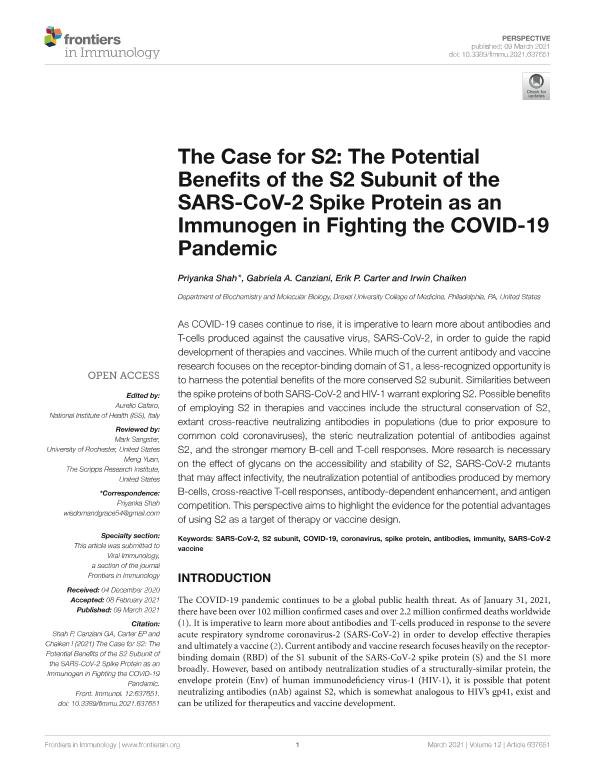Mostrar el registro sencillo del ítem
dc.contributor.author
Shah, Priyanka
dc.contributor.author
Canziani, Gabriela Alicia

dc.contributor.author
Carter, Erik P.
dc.contributor.author
Chaiken, Irwin
dc.date.available
2023-09-13T15:39:24Z
dc.date.issued
2021-03
dc.identifier.citation
Shah, Priyanka; Canziani, Gabriela Alicia; Carter, Erik P.; Chaiken, Irwin; The Case for S2: The Potential Benefits of the S2 Subunit of the SARS-CoV-2 Spike Protein as an Immunogen in Fighting the COVID-19 Pandemic; Frontiers Media; Frontiers in Immunology; 12; 3-2021; 1-7
dc.identifier.issn
1664-3224
dc.identifier.uri
http://hdl.handle.net/11336/211394
dc.description.abstract
As COVID-19 cases continue to rise, it is imperative to learn more about antibodies and T-cells produced against the causative virus, SARS-CoV-2, in order to guide the rapid development of therapies and vaccines. While much of the current antibody and vaccine research focuses on the receptor-binding domain of S1, a less-recognized opportunity is to harness the potential benefits of the more conserved S2 subunit. Similarities between the spike proteins of both SARS-CoV-2 and HIV-1 warrant exploring S2. Possible benefits of employing S2 in therapies and vaccines include the structural conservation of S2, extant cross-reactive neutralizing antibodies in populations (due to prior exposure to common cold coronaviruses), the steric neutralization potential of antibodies against S2, and the stronger memory B-cell and T-cell responses. More research is necessary on the effect of glycans on the accessibility and stability of S2, SARS-CoV-2 mutants that may affect infectivity, the neutralization potential of antibodies produced by memory B-cells, cross-reactive T-cell responses, antibody-dependent enhancement, and antigen competition. This perspective aims to highlight the evidence for the potential advantages of using S2 as a target of therapy or vaccine design.
dc.format
application/pdf
dc.language.iso
eng
dc.publisher
Frontiers Media

dc.rights
info:eu-repo/semantics/openAccess
dc.rights.uri
https://creativecommons.org/licenses/by-nc-sa/2.5/ar/
dc.subject
ANTIBODIES
dc.subject
CORONAVIRUS
dc.subject
COVID-19
dc.subject
IMMUNITY
dc.subject
S2 SUBUNIT
dc.subject
SARS-COV-2
dc.subject
SARS-COV-2 VACCINE
dc.subject
SPIKE PROTEIN
dc.subject.classification
Otras Biotecnologías de la Salud

dc.subject.classification
Biotecnología de la Salud

dc.subject.classification
CIENCIAS MÉDICAS Y DE LA SALUD

dc.title
The Case for S2: The Potential Benefits of the S2 Subunit of the SARS-CoV-2 Spike Protein as an Immunogen in Fighting the COVID-19 Pandemic
dc.type
info:eu-repo/semantics/article
dc.type
info:ar-repo/semantics/artículo
dc.type
info:eu-repo/semantics/publishedVersion
dc.date.updated
2023-09-13T11:57:03Z
dc.journal.volume
12
dc.journal.pagination
1-7
dc.journal.pais
Suiza

dc.description.fil
Fil: Shah, Priyanka. Drexel University; Estados Unidos
dc.description.fil
Fil: Canziani, Gabriela Alicia. Consejo Nacional de Investigaciones Científicas y Técnicas. Oficina de Coordinación Administrativa Parque Centenario. Instituto de Ciencia y Tecnología "Dr. César Milstein". Fundación Pablo Cassará. Instituto de Ciencia y Tecnología "Dr. César Milstein"; Argentina
dc.description.fil
Fil: Carter, Erik P.. Drexel University; Estados Unidos
dc.description.fil
Fil: Chaiken, Irwin. Drexel University; Estados Unidos
dc.journal.title
Frontiers in Immunology
dc.relation.alternativeid
info:eu-repo/semantics/altIdentifier/url/https://www.frontiersin.org/articles/10.3389/fimmu.2021.637651/full
dc.relation.alternativeid
info:eu-repo/semantics/altIdentifier/doi/http://dx.doi.org/10.3389/fimmu.2021.637651
Archivos asociados
